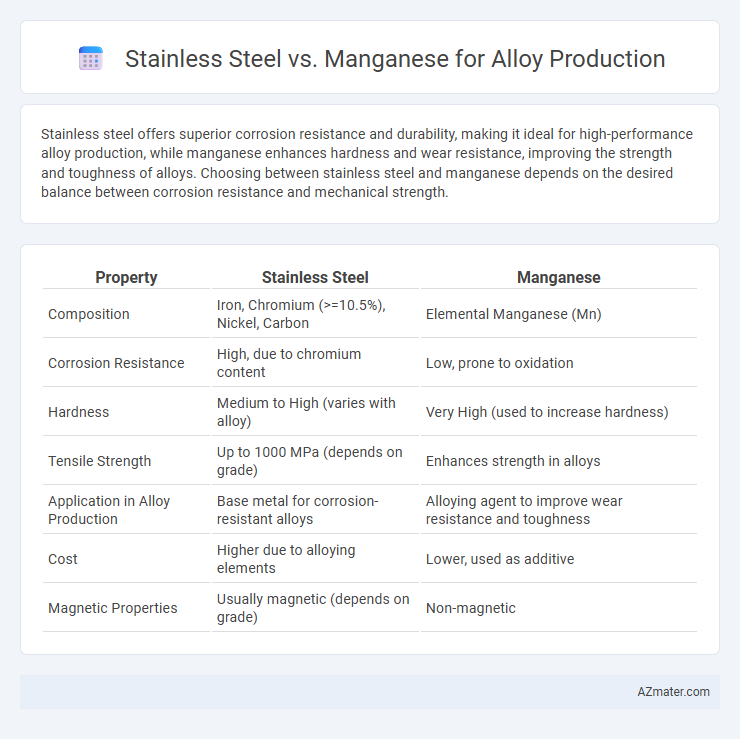Stainless steel offers superior corrosion resistance and durability, making it ideal for high-performance alloy production, while manganese enhances hardness and wear resistance, improving the strength and toughness of alloys. Choosing between stainless steel and manganese depends on the desired balance between corrosion resistance and mechanical strength.
Table of Comparison
| Property | Stainless Steel | Manganese |
|---|---|---|
| Composition | Iron, Chromium (>=10.5%), Nickel, Carbon | Elemental Manganese (Mn) |
| Corrosion Resistance | High, due to chromium content | Low, prone to oxidation |
| Hardness | Medium to High (varies with alloy) | Very High (used to increase hardness) |
| Tensile Strength | Up to 1000 MPa (depends on grade) | Enhances strength in alloys |
| Application in Alloy Production | Base metal for corrosion-resistant alloys | Alloying agent to improve wear resistance and toughness |
| Cost | Higher due to alloying elements | Lower, used as additive |
| Magnetic Properties | Usually magnetic (depends on grade) | Non-magnetic |
Introduction to Alloy Production
Alloy production harnesses the unique properties of metals like stainless steel and manganese to enhance material performance. Stainless steel alloys offer corrosion resistance and strength, making them ideal for applications requiring durability and longevity. Manganese, known for improving hardenability and tensile strength, is often added to steel to increase wear resistance and toughness in industrial alloys.
Overview of Stainless Steel
Stainless steel is an alloy primarily composed of iron, chromium (typically 10.5% or more), and varying amounts of nickel and other elements, known for its corrosion resistance and strength. Its microstructure can be austenitic, ferritic, martensitic, or duplex, affecting its mechanical properties and applications across industries such as construction, automotive, and medical devices. The chromium content forms a passive oxide layer, providing stainless steel with enhanced durability compared to manganese alloys, which are often used for their impact resistance and toughness rather than corrosion resistance.
Properties of Manganese Alloys
Manganese alloys exhibit exceptional hardness, high tensile strength, and significant resistance to wear and abrasion, making them ideal for industrial applications requiring durability. Their excellent deoxidizing and desulfurizing properties enhance steel quality by improving toughness and ductility. These alloys retain magnetic properties and demonstrate superior performance in harsh environments compared to stainless steel, particularly in heavy machinery and construction industries.
Key Differences: Stainless Steel vs Manganese
Stainless steel is primarily an iron-carbon alloy with a minimum of 10.5% chromium, providing exceptional corrosion resistance and strength, while manganese is a chemical element used mainly as an alloying agent to improve hardness and tensile strength in steel. The key difference lies in their application: stainless steel is a finished alloy known for durability and resistance to oxidation, whereas manganese serves as an additive that enhances the mechanical properties of various steel types. Stainless steel alloys often contain additional elements like nickel and molybdenum, whereas manganese content varies depending on the desired impact on steel's toughness and workability.
Composition and Metallurgical Structure
Stainless steel alloys primarily contain iron, chromium (typically 10.5-30%), and varying amounts of nickel, molybdenum, and carbon, which form a corrosion-resistant face-centered cubic (FCC) or body-centered cubic (BCC) crystalline structure depending on the grade. Manganese alloys, composed mainly of manganese (60-80%), iron, and carbon, develop a complex microstructure featuring high hardness and wear resistance due to the formation of manganese carbides and a predominantly austenitic matrix. The metallurgical differences influence alloy applications, with stainless steel excelling in corrosion resistance and manganese alloys favored for toughness and abrasion resistance.
Mechanical Strength Comparison
Stainless steel alloys exhibit superior tensile strength and corrosion resistance compared to manganese-based alloys, making them ideal for applications requiring both durability and environmental resistance. Manganese alloys offer enhanced impact toughness and wear resistance due to higher hardness and better work hardening capacity, but typically have lower yield strength than stainless steel. The choice between stainless steel and manganese hinges on balancing the need for mechanical strength versus toughness and abrasion resistance in specific alloy production scenarios.
Corrosion Resistance Factors
Stainless steel exhibits superior corrosion resistance due to its high chromium content, which forms a passive oxide layer that protects against rust and chemical degradation. Manganese, while beneficial for enhancing strength and toughness in alloys, provides limited corrosion resistance and can promote susceptibility to rust under certain environmental conditions. The choice between stainless steel and manganese alloys depends heavily on the required balance of corrosion resistance and mechanical properties for specific applications.
Industrial Applications of Each Alloy
Stainless steel, known for its excellent corrosion resistance and strength, is widely used in industrial applications such as chemical processing, food manufacturing, and automotive components where durability and hygiene are crucial. Manganese alloys, valued for their hardness and resistance to abrasion, are primarily utilized in heavy machinery, steel production, and wear-resistant equipment like crusher liners and railroad tracks. Each alloy's distinct mechanical properties dictate their specific roles across diverse industrial sectors, optimizing performance and longevity.
Cost and Availability Analysis
Stainless steel, primarily composed of iron, chromium, and nickel, offers moderate cost with high availability due to widespread global production and recycling infrastructure. Manganese, used as an alloying agent to improve strength and hardness, is generally less expensive but has fluctuating availability tied to mining output and regional reserves, particularly in countries like South Africa and Australia. Cost efficiency in alloy production depends on the balance between stainless steel's consistent supply and manganese's variable price influenced by geopolitical and market factors.
Sustainability and Environmental Impact
Stainless steel offers superior corrosion resistance and recyclability, making it a sustainable choice with a lower environmental footprint due to its high scrap recovery rate. Manganese, essential in alloy production for improving steel hardness and durability, requires intensive mining processes that contribute to habitat disruption and higher carbon emissions. Prioritizing stainless steel alloys with recycled content can significantly reduce energy consumption and environmental degradation compared to manganese-intensive alternatives.

Infographic: Stainless steel vs Manganese for Alloy production
 azmater.com
azmater.com